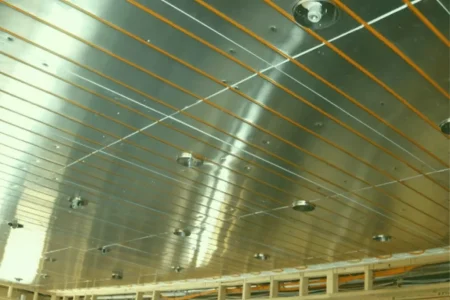Radiant ceiling heat has been available in some form for over 50 years. In an effort to improve upon radiators and space heaters, radiant ceiling heat was designed to provide consistent, even warmth.
Most radiant ceiling heat designs use electricity to warm an element, and allow the heat to radiate. Because this design uses electric resistance, the system itself can get quite warm, prompting questions regarding its safety.
Generally speaking, radiant ceiling heat products require UL approval, which make them safe to use as long as they are in good repair. However, UL requirements have changed over time, so products that may have been considered safe originally may not meet today’s more stringent standards.
In this article, we will talk about radiant ceiling heat with the main pros and cons of this kind of system. So let’s get right to it.
What Is Radiant Ceiling Heat?
Radiant ceiling heat was introduced in the middle of the 20th century as more people could afford to purchase a home. At the time, the primary way most homeowners heated their home was with boilers, radiators, and space heaters.
Each of these methods had drawbacks, such as inefficient operation and inconsistent heating. Some versions used electricity or gas to circulate warm water, while others used some form of electrical resistance to produce heat.
Radiant ceiling heat was originally designed to reduce the inconsistent heat problem by spreading the heating out over the entire room. This was in contrast to a traditional radiator, which was a single source of heat within the room.
The radiator’s design often made some areas too hot and some areas too cold. Electric space heaters and electric wall mounted heaters were also very common, but unfortunately, they had the same inefficient operation.
Radiant ceiling heat addressed these problems by using a system of either electrically heated cables or radiant heating panels spread around the room. These designs were permanently mounted, and often became the home’s primary source of heat.
What Are the Pros Of Radiant Ceiling Heat?
The answer depends on which version of ceiling heat being used, but most versions provide similar benefits. Here are a few:
Very Easy to Use
Radiant ceiling heat was one of the first permanent home heating systems to employ a thermostat. This was a huge feature at the time, because in previous years, the technology was not available.
Looking for the best radiant heat thermostat? Check out this article.
The use of thermostats made the system extremely easy to use, much like it is today. This was a leap forward in convenience, compared to the limited control available from space heaters and radiators.
Radiant Ceiling Heat is Dependable
Radiant ceiling heat is of simple design, and does not require complicated technology to operate. Compared to other heating methods, radiant ceiling heat is virtually silent, very clean, and eliminates many concerns, like open flames.
Since it is connected directly to the home’s electrical service panel, the system can operate independently using a thermostat. The system is typically on a dedicated circuit, meaning no other devices shares the same electrical supply. This design makes the system dependable and simple to use, especially when compared to other heat sources.
Customizable
Because radiant ceiling heat is a system and not a device, it can be customized for the space. If rooms were larger, additional panels could be connected together to form a unit. With the plaster version, additional wire could be added wherever it was needed, increasing the size of the system.
What Are the Cons Of Radiant Ceiling Heat?
Unfortunately, radiant ceiling heat does have a few major drawbacks. These are mostly a result of the design, not the build quality. Most systems used in the past were well built and safe to use, but the design made them very inefficient by today’s efficiency standards and costly to operate. Here are a few downsides to radiant ceiling heat:
Relatively Expensive
Because the system requires specialized installation, the system is fairly labor intensive to install. The components are not typically interchangeable with other heating methods either, so the system tends to be expensive to own. Because this system requires that it be surrounded by drywall or plaster, additional labor and materials are often required.
Inefficient to Use
Ironically, although radiant ceiling heat was considered a step forward in efficiency compared to radiators and space heaters, by today’s standards it is quite inefficient to operate.
Obviously, heat rises, so the system does not function well in homes with high ceilings or sparse attic insulation. In these homes, many users found that ceiling fans and other components were required to push the heated air down to the occupants.
Difficult to Repair
Although these systems are relatively durable, they are very difficult to repair in the event of a failure. This was because failures were often due to a break in the heated wire cable caused by an errant nail or screw. Generally, this does not cause an unsafe condition, as the voltage is quite low and unlikely to reach the ignition temperature required to start a fire.
However, since the wire cable is usually encased in other materials, diagnosing breaks in the cable is very difficult. Fortunately, once the system is installed, most issues are a result of the mechanical components that supplied the electrical current. These components are generally accessible, serviceable, and replaceable.
Is Radiant Ceiling Heat Used In Older Homes?
Older homes are more likely to have radiant ceiling heat than modern homes. As such, over the years many systems have been abandoned in favor of heat pumps and furnaces.
However, some older homes may still have operational systems. Because these systems had essentially no moving parts, they tended to enjoy long, useful lives. However, as modern construction designs evolved into larger homes with higher ceilings, these systems were sometimes abandoned in favor of more efficient forced air systems, like a heat pump.
What Is Plaster Ceiling Radiant Heat?
Plaster ceiling radiant heat is generally considered typical of a ceiling heat system. This design used a wire cable to gently warm a gel-like conductor inside the cable. This conductor then radiated the heat from the cable, warming the surrounding area.
Generally speaking, this cable was sandwiched between two layers of drywall or plaster, which absorbed the radiated heat and transferred it to the room. Because this method protected the cable, it tended to be very reliable.
However, this design required more materials (double drywall or double plaster), so the installation was generally more expensive to install. The cable was then connected permanently to a thermostat and electric heat source, which at the time, was considered technologically advanced.
Conclusion
Radiant ceiling heat is generally considered safe and reliable, if not energy efficient. Because these systems employ mostly passive components, they tend to last a long time.
However, for those homes still using ceiling radiant ceiling heat, professionals strongly advise owners to have their system inspected periodically by a qualified professional. This will ensure that the system will remain safe and simple to operate.

Nick Lopresti is the founder of YourH2Home and a home improvement expert. He has years of experience writing about various home improvement topics, mostly as it pertains to water systems.
